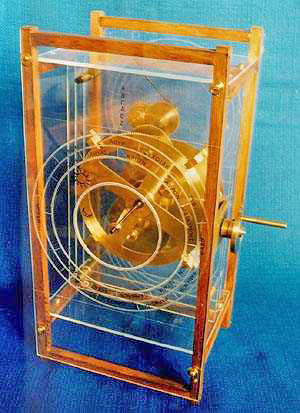|


by John Gleave
from
GrandIllusions Website
In the year 1900 the bronze remains of a mechanical device
were retrieved from a shipwreck off Antikythera, near
Crete.
It was not clear initially what the device was, except that it was
clearly a sophisticated mechanism. X-ray analysis was subsequently
used to probe the inner structure of the device, the details of the
gears. Finally in 1974, a full analysis was published by
Professor D. De Solla Price. While some of the original gearing
was missing, there was enough to work out that the device was
intended to show the motion of the Moon, Sun, and most likely the
Planets through the years, when the handle was turned. A few years
ago, John Gleave, an orrery maker based in the United
Kingdom, decided to construct a working replica of the original
mechanism.

A full scale
reconstruction of the Antikythera mechanism
Height 12.25 inches
The front dial - showing the annual
progress of the sun & moon through the zodiac, against the Egyptian
calendar, rendered in Greek on the outer annulus

The back dials
The upper back dial displays a four year
period and has five concentric inscribed rings, most probably each
with 47 divisions giving the Metonic Cycle of 235 synodic months,
which equals 19 solar years. The lower back dial gives the cycle of
a single synodic month, and the subsidiary dial the Lunar year of
12 synodic months.
The original gearing was cut from bronze, and the 60 degree
triangular teeth were finished using a file. In the reconstruction,
the gearing is made from brass, set between perspex plates,
with perspex dials in place of the original bronze, so that the
mechanism is visible.
The instrument indicates that the technology of the time, of
which this is the only surviving example, was by any measure
sophisticated.
|

